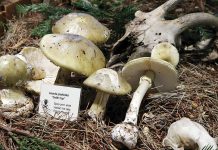
For most of us, autumn is the time of year we shake off the lazy days of summer and get down to the serious business of food. Resourceful folks are canning their autumn harvests of pumpkins, pears, persimmons and peppers. People are busily preparing days ahead for sumptuous holiday feasts to share with their families and friends.
Fall is also the season for a flurry of activity among wildlife to enable their survival during cold winter months: Cliff swallows and rufous hummingbirds are migrating south to warmer climates with a more plentiful supply of insects, bears and marmots are fattening up and preparing dens for hibernation, and squirrels and acorn woodpeckers are gathering and hoarding thousands of nuts in tree granaries to eat in the winter when food is scarce. Though Clarabelle, the Wildlife Education and Rehabilitation Center’s educational, non-releasable acorn woodpecker doesn’t have to worry about being sheltered from inclement weather or having enough to eat—at any time of the year. She is provided with plenty of acorns, pine nuts and peanuts, live worms and fresh fruit inside her roomy aviary.
We humans are fortunate, too—if we’ve forgotten an ingredient for making that cinnamon crumble apple pie or garlic mashed potatoes, just grab a shopping list and head on down to the corner grocery store. On blustery, cold days, we can snuggle up with cozy blankets before a fireplace. Our local wildlife doesn’t have it so easy, what with the summer’s dry season causing a shortage of edible vegetation and prey animals such as field rodents. Homes and businesses constructed during spring and summer months often force wildlife further away from their natural habitats. You can help the wildlife’s chances of survival by providing sources of food, fresh water and shelter.
Planting native trees will give food and shelter to birds, squirrels and other small animals. Plant winter flowers such as Kniphofia, and keep your birdbath and birdfeeders, including hummingbird feeders, clean and filled. Put out bowls of meal worms for the insectivorous critters. Year-round birds such as emerald-and-scarlet Anna’s hummingbirds, wintering birds such as golden-crowned sparrows and orange-and-black varied thrushes and avian travelers such as red-yellow-and black western tanagers just stopping by on their migratory route will be most thankful and you might have a rainbow of autumn and winter colors in your yard, come rain or shine.
Speaking of migration, be a dear to deer and drive with extra caution: October to December is deer migrating season. The drought has caused wildlife to come closer to human habitation and roads in search of food and water. There are more than 100,000 deer-and-vehicle collisions reported each month in the United States. Here are a few safety reminders may help prevent this tragic occurrence:
– Slow down.
– Deer are most active at night between 6 and 9 p.m.
– Be aware of your surroundings. Watch for posted deer crossing signs.
– Use high beam headlights as much as possible at night.
– Deer usually travel in herds—if you see one, it’s likely that more are following.
– If a collision seems inevitable, don’t swerve to avoid the animal. Hitting oncoming traffic could be even worse. Be prepared to brake hard. If you do hit a deer, do not attempt to move or rescue the deer yourself. They are very dangerous animals. Call 911 to report the accident.
By driving carefully at night, you may also save the lives of other nocturnal animals, such as bobcats, raccoons, badgers, opossums and coyotes that could be out looking for food.
***
A heartfelt thank you to the wonderful WERC team: The volunteers who feed our animals, clean up after them, tend to injuries, build and maintain enclosures and participate in public events; our veterinarians who donate expertise and time in the care and treatment of the animals; and to all of our generous supporters who help us provide food and shelter for our educational and rehabilitation animals.
The Wildlife Education and Rehabilitation Center rehabilitates native wildlife and is supported solely by donations from businesses and the public. To contact WERC, call (408) 779-9372 or visit werc-ca.org.













